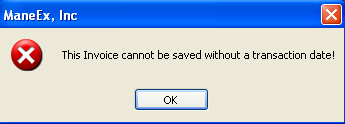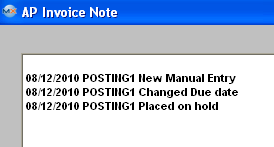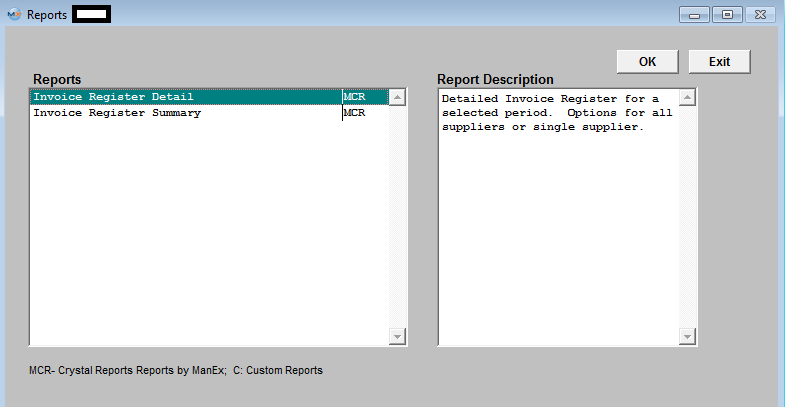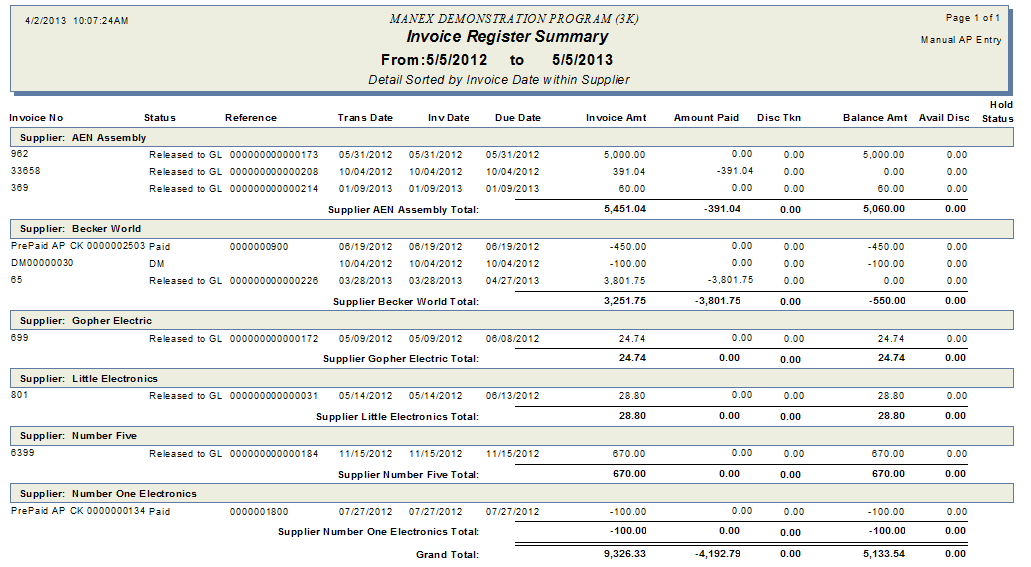| 1.1. Prerequisites for Manual A/P Entries |
Users MUST have full rights to the "Manual AP Entry" in Accounting Security . Users with “Accounting Security Supervisor” rights will automatically have access. |
| 1.2. Introduction for Manual A/P Entries | The Manual A/P Entries selection provides on screen and printed reports to assist the tracking and payment of manual invoice entries. The user may enter this module to input invoices which have no accompanying Purchase Order.
|
| 1.3. Fields & Definitions for Manual A/P Entries |
| 1.3.1. Manual AP Entry | |
Manual AP Entry tab field Definitions
  |
This toggle button will either put item on hold or remove item from hold. NOTE: This button will only be available if the record status is "Editable" or if the record status is "Released to GL" and the record is on "Pmt Hold".
|
|
Hold Status
|
If an invoice is placed on Hold this field will display the type of Hold Status such as "Pmt Hold". If an Invoice is on "Pmt Hold" user can still release and post the invoice to the GL. If the status of the Invoice is "Released to GL", this record will not be Editable, but the "Remove Hold" button, will be available.
|
|
Supplier
|
The name of the Supplier |
|
Invoice Number
|
The supplier’s Invoice Number |
|
PO/Reference
|
The Purchase Order number or other reference.
|
|
Transaction Date
|
This column will display the date of the transaction.
|
|
Invoice Date
|
The date of the Supplier’s invoice.
|
|
Due Date
|
The date the invoice is due to the supplier
|
| Terms |
This is the Payment Terms setup in Supplier Info. |
|
AP Status
|
Editable – this means that most of the fields are eligible for changes.
Paid Only – this means that the invoice has been paid manually and removed from the AP Aging records, but has not been released or posted yet, . The invoices with this status can NOT be edited.
Released to GL – this means that the invoice has been released and/or posted to GL, but is still open in the A/P Aging and is unpaid. The invoices with this status can NOT be edited because they’ve already been released to G/L. NOTE: If they are on "Pmt Hold" the "Remove Hold" button will be available, so user can remove the invoice from payment hold so Invoice will be displayed in AP Check Payment.
Paid/Rel to GL – this means that the Check has been written for the invoice and it has been released and posted to the G/L. Thes invoices with this status can NOT be edited.
Deleted – this means that the invoice/record has been deleted, and the invoice/record can NOT be reinstated.
|
|
Total Amount
|
This is the total amount of the invoice.
|
 |
If lit in RED, there is a note regarding the invoice. |
 |
This will take the user to the pertinent addresses for this Supplier |
|
Item
|
The item number of the invoice.
|
|
Description
|
The description of the purchase.
|
|
Quantity
|
The amount purchased.
|
|
Price Each
|
The price to be paid to the supplier.
|
|
Total
|
The total of the invoice.
|
|
Tax Pct
|
The sales tax percentage the supplier charged the user.
|
|
GL Number
|
The General Ledger Number to which the item was charged.
|
|

|
Add special detail for line item
|
|

|
Delete special detail for line item
|
 |
If lit in RED, a note exists regarding the detail line. |
|
Total Tax
|
This is the total of the sales tax on all of the line items.
|
|
Total Incl Tax
|
This is the grand total of the invoice due the supplier.
|
|
Date Last Changed
|
The last change made to the invoice.
|
|
Reason
|
The reason for the change.
|
|
By
|
The initials of the user who made the change.
|
|
| 1.4. How To ..... for Manual A/P Entries |
| 1.4.1. Find a Manual AP Entries | |
|
Enter the SQLMANEX.EXE (within the ManEx root directory)
This action will then prompt the user for a password
|
 |
The following screen will be displayed, select Accounting/Accounts Payable/ Manual AP Entries
|
 |
The following screen will be displayed:
|
Depress the Find record action button, the following screen will be displayed:
Select the desired Filter: by selecting the appropriate radio button– Editable, All, Pmt Hold, Paid Only, Released to GL Only, or Paid & Rel to GL.
Select the desired Find: - by selecting the appropriate radio button – Supplier Name, Supplier Invoice No., Due Date Range, All, Reference/PO No., or Transaction Date Range.
Enter the information into the red box, depress the enter key and the information will populate the screen.
|
 |
If user selects ANY of the Filters and Find by All - a screen will appear listing all the Manual AP Entries per the filter selected, alphabetical by Supplier name, Invoice Amount, Invoice number, AP status, and Invoice date.
The user has the option to view the AP Manual Entry by either entering the Invoice number into the red box, or scrolling down the list, highlighting the desired record and double click on it.
|
 |
Filter:
| Editable |
This means that most of the fields are eligible for changes. |
| Pmt Hold |
These have been put on payment hold. |
| Released to GL Only |
These are still open in the A/P Aging and are unpaid. These can’t be edited because they’ve already been released to G/L. |
| Paid & Rel to GL |
Checks have been written for the invoices and they have been released to the G/L. These can’t be edited. |
| All |
All Records |
| Paid Only |
Checks have been written for these invoices.These can’t be edited. |
Sort By:
| Supplier |
Must Enter in The Supplier Name |
| Supplier Invoice No |
Each Supplier Invoice Number |
| Due Date Range |
Enter Specific Date Range |
| All |
All Records |
| Reference/PO No |
Enter Reference No or PO No |
| Transaction Date Range |
Enter Specific Transaction Date Range |
Once the selection is made, depress the "OK" button. The screen will update with data from the selection:
|
| 1.4.2. Add a Manual AP Entries | Adding Manual Invoices
Manual AP Entry tab Note: Do NOT use for inventory receipts!
|
Enter the SQLMANEX.EXE (within the ManEx root directory)
This action will then prompt the user for a password
|
 |
|
The following screen will be displayed, select Accounting/Accounts Payable/Manual A/P Entries
|

|
The following screen will be displayed:
Select the Add button and enter in your password. The following screen will appear: The transaction date will default in for the current day and time, but is editable.
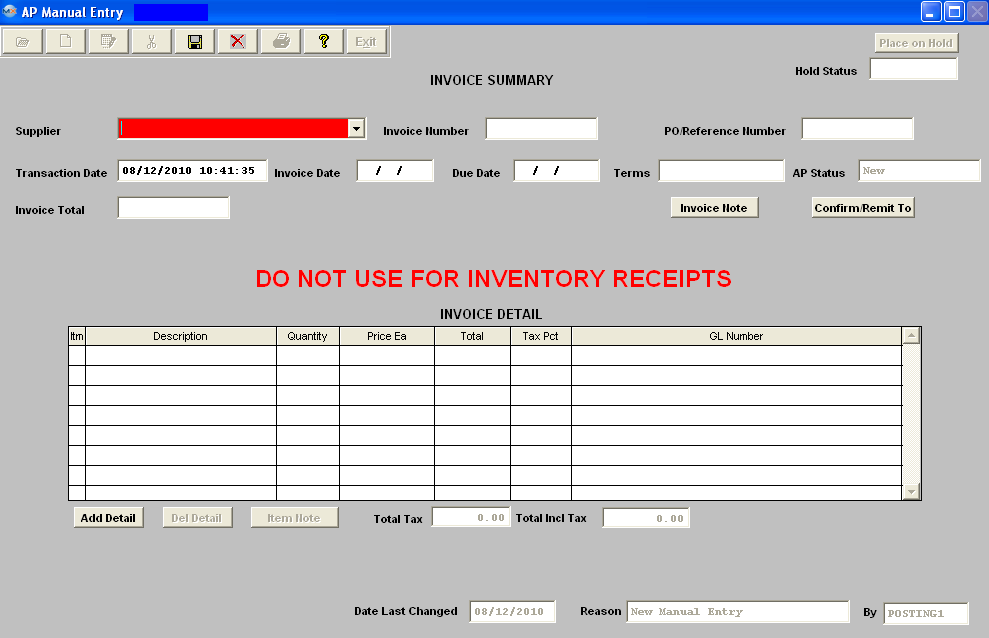
| Depress the down arrow next to the Supplier Name field. The following list will appear:
Select the Supplier. Once the suppler is selected the Terms will default in from the Supplier Info.
|
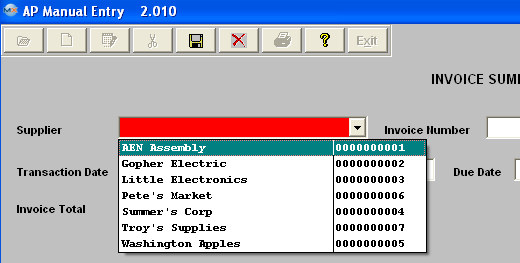 |
Enter an Invoice Number ("DM" is disallowed as the two left characters of the invoice number) and Invoice Date.
Enter a PO/Reference number if applicable.
Enter in the Invoice date and the Due date.
Enter in the total amount of the Invoice.
If you want to add an Invoice Note, depress the Invoice Note button. Depress the Edit button. Type in the invoice note. Depress the Save button. Depress the Exit button.
If you want to check on the Supplier’s CONFIRM/REMIT TO information, depress that button. Information regarding the Supplier addresses will appear on the screen.
The user may change the TERMS by depressing the down arrow next to the Terms field and selecting a new term. The user may also change the CONFIRM TO address or the REMIT TO address by depressing the arrows next to those fields and selecting a new address.
Depress the Add Detail button at the bottom of the screen.
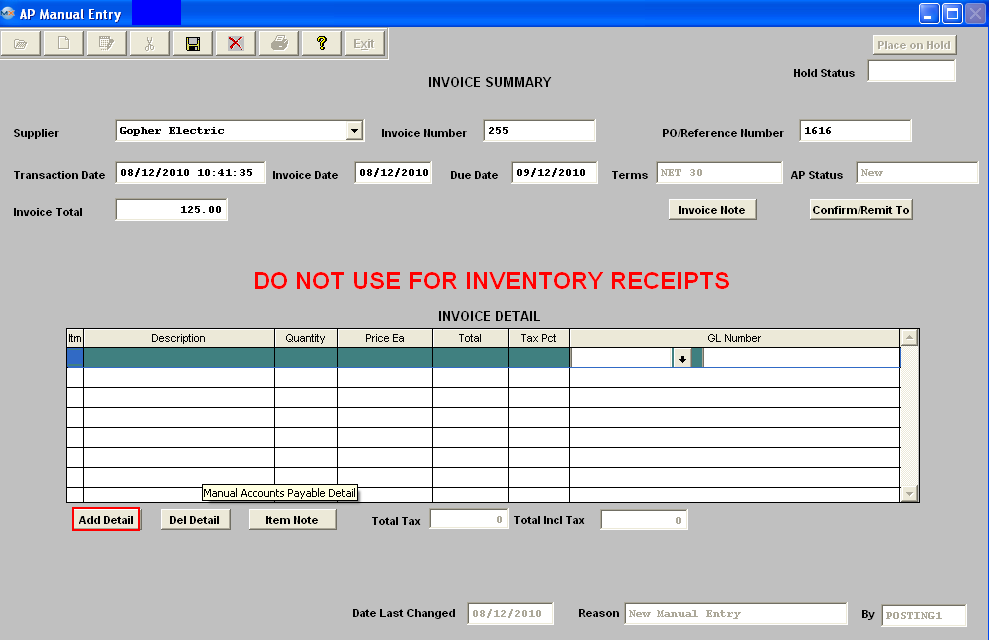
In the Invoice Detail Information section, enter in the Item Number, Description, Quantity, and Price Each. The Total column will update automatically. Enter in the Tax Percentage.(For example, a tax rate of 8 1/2 percent would be entered as 8.50), if applicable. Enter in the General Ledger Account Number.
| To look up a GL Account Number. Double click in the GL Number field. The following screen will appear: |
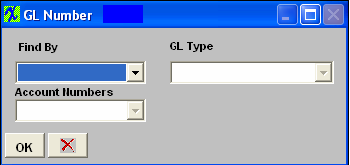 |
| Depress the arrow next to the Find By field. The following selection will appear: |
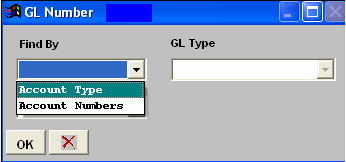 |
|
If you select Account Type, the following list will appear:
|
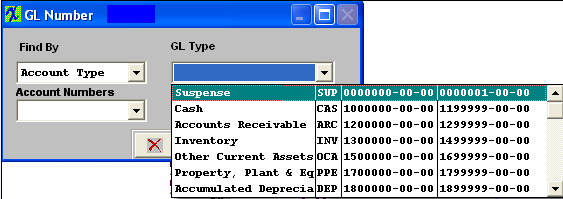 |
Select the GL Type. The following list of accounts within that type will appear:
Select the desired GL Account Number. Depress the OK button.
|
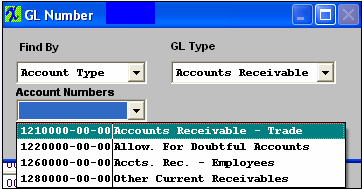 |
|
If you select Account Number, the following list will appear:
Select the desired GL Account Number. Depress the OK button.
|
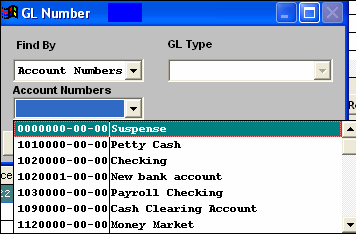 |
To add an Item Note, depress the Item Note button. Depress the Edit button. Type in the note. Depress the Save button. Depress the Exit button. The note button will light up in red.
Continue to add detail using the above procedures until the entire invoice amount has been covered and exactly matches the total amount column in the top section of the screen.
Depress the Save button at the top of the screen the Status will update from "New" to "Editable" and user will receive the following message:
 .
Note: If the two total amounts do not exactly match user will receive the following message:
If the Transactions Date is left blank user will recieve the following message and will NOT be able to Save the record until this field is populated:
Invoice will then be transfered to the Release and Post screen . Once the record has been released and posted to the GL the status will updated from "Editable" to "Released to GL".
|
| 1.4.3. Edit a Manual AP Entries | Editing Manual AP Entries : If the Manual AP Entry Status is Editable and has NOT been released/posted to the GL, the user will have the ability to Edit the Invoice from the Manual AP Entry screen. All Editing for Purchase Order Invoices already transferred to the Accounts Payable Aging module MUST be edited in the Manual Invoicing module.
|
Enter the SQLMANEX.EXE (within the ManEx root directory)
This action will then prompt the user for a password
|
 |
The following screen will be displayed, select Accounting/Accounts Payable/Manual AP Entries
|
 |
The following screen will be displayed:
Using the Find Procedures find a Manual AP Entry Record. Depress the Edit button and enter in your password.
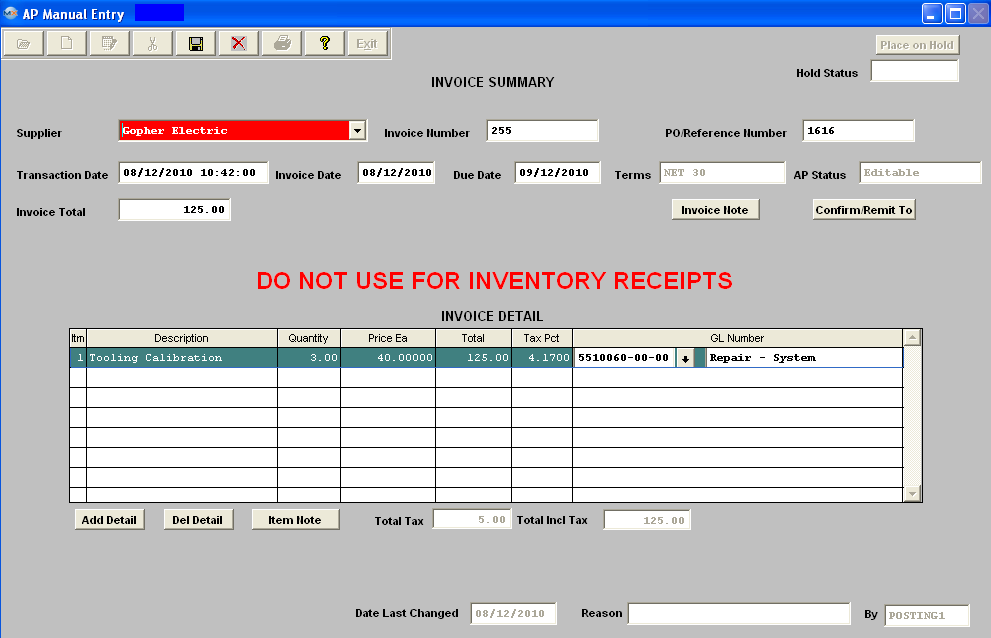
Make the desired changes. Enter in the Reason for the change. If you try to Save record without entering a the Reason you will receive the following message:
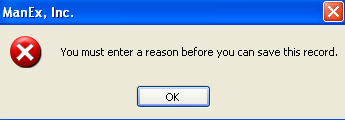
If you change any of the amounts, make sure that the "Invoice Total" field and the "Total Incl Tax" fields are equal. Note: If you change the Detail Total pricing, you MUST also change the Invoice Total at the top of the screen. If the two totals do NOT match user will receive the following message:

The user may add notes to both the Invoice Notes and the Item Notes. Depress the Edit button. Depress the Note button. Depress the Edit button. Type in the note.Depress the Save button. Depress the Exit button. The note button will light up in red.
The user may also change information in the Confirm/Remit To screen. Depress the Edit button. Depress the Confirm/Remit To button. The following screen will appear:
The user may change the TERMS by depressing the down arrow next to the Terms field and selecting a new term.
The user may also change the CONFIRM TO address or the REMIT TO address by depressing the arrows next to those fields and selecting a new address. Once the edited changes are complete, depress the Save button.
For future finds, the most recent edited change reason will display. If there was more than one edited change, depress the Invoice Note button to see all of the changes.
|
| 1.4.4. Delete a Manual AP Entries | Deleting an Manual AP Entry/Invoice
|
Enter the SQLMANEX.EXE (within the ManEx root directory)
This action will then prompt the user for a password
|
 |
|
The following screen will be displayed, select Accounting/Accounts Payable/Manual AP Entries
|
 |
The following screen will be displayed:
Find an Invoice with the status "Editable". Depress the Delete button.
Type in your password, you will receive the following warning:
Depress the Yes button to complete the deletion.
Note: Upon Deletion the system will then completely remove the original transaction for the Manual AP Entry that was waiting to be Release/Posted to the GL. If the Invoice you want to delete is NOT editable, please follow the procedures below:
If it’s a Manual Invoice or an MRO PO Invoice, use the Debit Memo procedures. If it’s an Inventory PO Invoice, use the DMR (Return to Vendor) procedures.
|
| 1.5. Reports for Manual A/P Entries | |
To obtain the Manual A/P Entry Reports within the Web, select the WEB Print button from the ManEx action buttons at the top
of the screen. For further detail on How the Reports work
within the Web refer to Article #5477.
Note: In order to access the Reports
within the Web the Company Root URL must be setup within the System Appearance module and user must be linked to web within the System Security Module.

Select
the Report Type: AP ENTRY - A List of Reports will be displayed that are
available on the Web for AP ENTRY
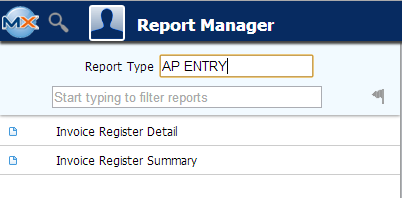
To obtain the Manual A/P Entries reports, select the Print button from the ManEx action buttons at the top of the screen.

The following reports screen will display a list of
reports that are available on the ManEx Desktop
Invoice Register Detail
|
Enter a "Start of Range" Date in format "yyyy-mm-dd". Enter a "End of Range" Date in format "yyyy-mm'dd". Note: User must enter a Start and End of Range date in order for report to print.
Select the Apply Date Range to: from drop down (or use default "Invoice Date").
Enter a Supplier: If all Suppliers are desired leave * defaulted.
Select the applicable AP Status from the drop down or use the default * and this will display all.
Select how you wish for the detailed information to be sorted within the report from the drop down (or use default Invoice Date).
Then depress the OK button.
|
 |
The following report will be displayed:
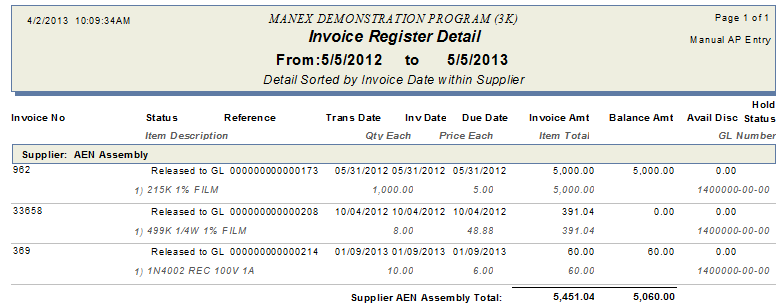
Invoice Register Summary
Enter a "Start of Range" Date in format "yyyy-mm-dd". Enter a "End of Range" Date in format "yyyy-mm'dd". Note: User must enter a Start and End of Range date in order for report to print.
Select the Apply Date Range to: from drop down (or use default "Invoice Date").
Enter a Supplier: If all Suppliers are desired leave * defaulted.
Select the applicable AP Status from the drop down or use the default * and this will display all.
Select how you wish for the detailed information to be sorted within the report from the drop down (or use default Invoice Date).
Then depress the OK button.
|

|
The following report will be displayed:
|
|


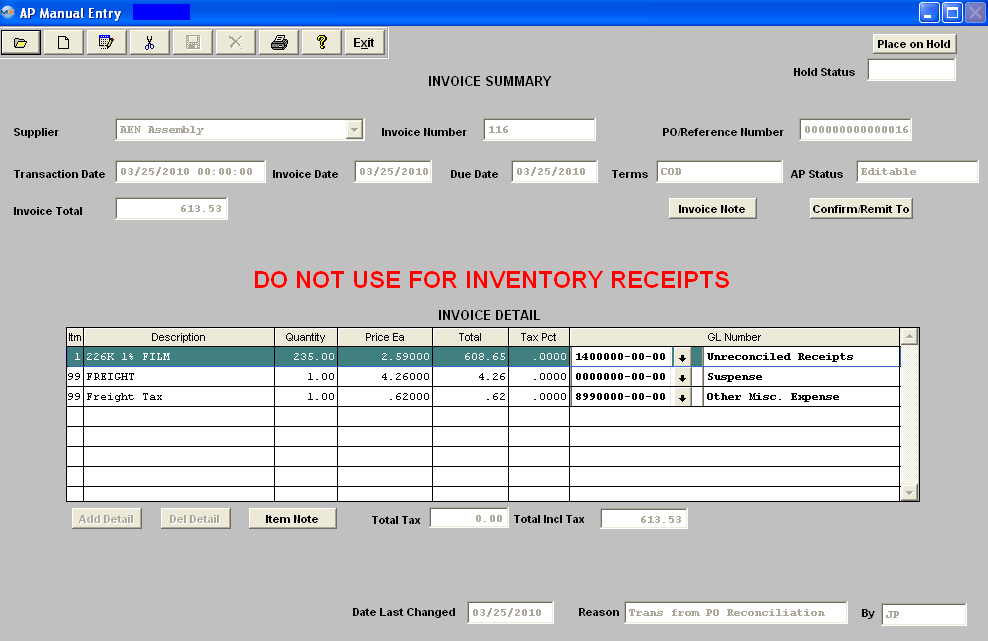


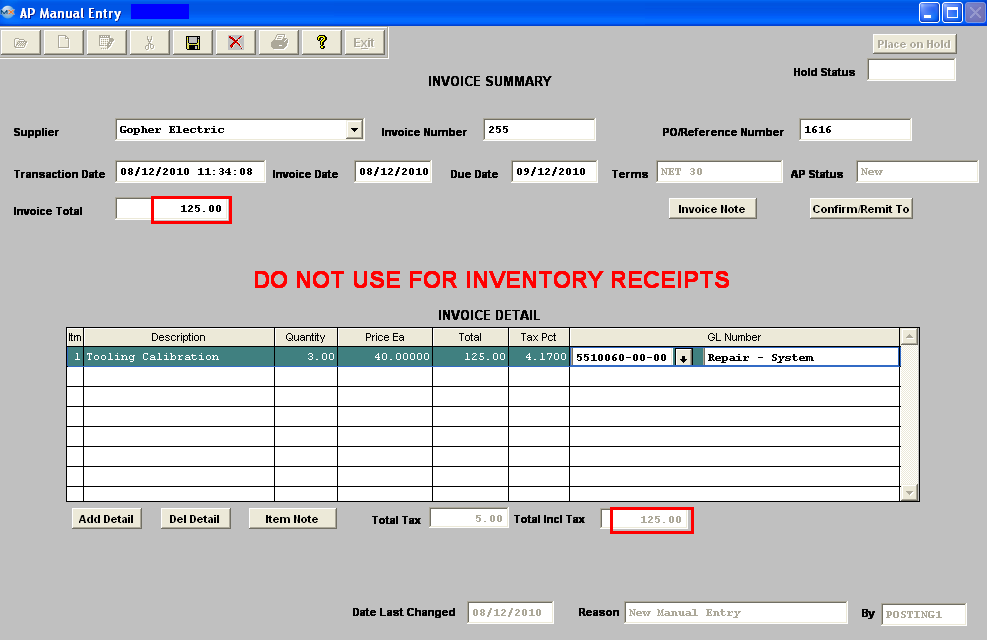
 .
. 
